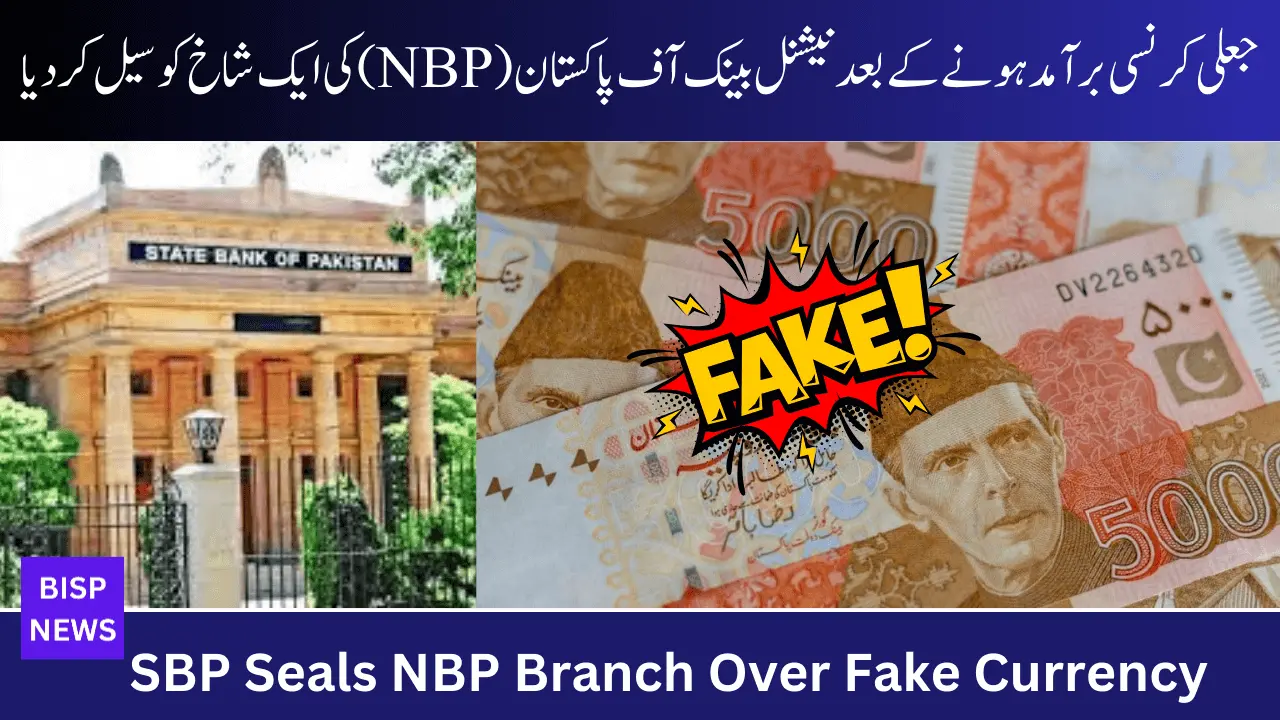SBP Seals NBP Branch Over Fake Currency Worth Rs 2 Million
In a shocking move, the State Bank of Pakistan (SBP) sealed a branch of the National Bank of Pakistan (NBP) after counterfeit currency worth Rs 2 million was discovered. This incident, which has sent ripples across the financial sector, raises serious concerns about the security of Pakistan’s banking system and the ongoing problem of counterfeit currency. The discovery has ignited questions about the effectiveness of current anti-counterfeiting measures and the steps necessary to strengthen currency security in Pakistan.
SBP Seals NBP Branch Over Fake Currency
The counterfeit currency was uncovered during a routine internal audit at an NBP branch. The bank officials found that a large sum, amounting to Rs 2 million, had been deposited in fake notes. Despite the bank’s efforts to trace the origin of these notes, they were unable to find any leads. In response, the SBP took the drastic step of sealing the branch and launching an investigation into the incident.

This move by the SBP underscores the seriousness of the issue and highlights the vulnerabilities within Pakistan’s banking infrastructure. While the central bank has established stringent guidelines for managing currency, incidents like this show that counterfeiters are still finding ways to exploit the system. As a result, the banking sector is now under increased scrutiny, and financial institutions must reassess their practices to safeguard against counterfeit currency.https://www.centralbanking.com/
The Growing Problem of Fake Currency in Pakistan
Counterfeit currency remains one of the most persistent threats to Pakistan’s economy. Despite advanced security features in banknotes, counterfeiters continuously develop more sophisticated methods to replicate these features. This makes it challenging for banks and businesses to detect fake notes before they enter circulation.
The implications of counterfeit currency are far-reaching:
- Inflationary Pressure: Fake notes contribute to inflation, as their circulation devalues the currency.
- Financial Instability: The presence of fake currency in circulation undermines the credibility of the financial system, causing instability in banks and other financial institutions.
- Impact on Businesses: Businesses, particularly those relying on cash transactions, struggle to detect counterfeit bills, leading to financial losses.
The recent discovery of Rs 2 million in fake currency at an NBP branch highlights how deeply entrenched the issue of counterfeit money is in Pakistan. It serves as a stark reminder that more needs to be done to address this growing problem.
SBP’s Response and the Need for Stricter Measures
The SBP’s immediate response was to seal the NBP branch and initiate an investigation to determine the source of the counterfeit currency. This step demonstrates the SBP’s commitment to maintaining the integrity of Pakistan’s financial system. As the regulatory authority overseeing Pakistan’s financial institutions, the SBP’s role is crucial in ensuring that banks adhere to anti-counterfeit guidelines and maintain strict currency security protocols.
The SBP has also directed all commercial banks to review their internal procedures for handling currency and to ensure compliance with anti-counterfeiting regulations. These measures are likely to include:
- Enhanced training for bank staff on detecting counterfeit currency.
- Investments in advanced counterfeit detection technologies to better identify fake notes.
- Stricter monitoring of currency handling processes to prevent the entry of counterfeit bills into the banking system.
Technological Solutions: A Key to Combating Counterfeit Currency
One of the most effective ways to address the issue of fake currency is through technology. While the SBP has introduced advanced security features in Pakistan’s banknotes, counterfeiters have become increasingly adept at mimicking these features. To combat this, financial institutions must invest in state-of-the-art counterfeit detection systems.
Some of the most promising technological solutions include:
- High-resolution scanning systems: These can detect even the smallest discrepancies in the printing of currency notes.
- UV light detectors: These systems can identify the hidden security features in genuine notes.
- Machine learning-based devices: These tools can analyze patterns and identify counterfeit bills with greater accuracy.
By integrating these technologies into their operations, banks can significantly reduce the risk of counterfeit currency entering circulation.
Rebuilding Public Trust and Confidence
The circulation of counterfeit currency has a significant psychological impact on the public’s trust in the banking system. Consumers may feel apprehensive about depositing their money in banks, fearing that they could unknowingly receive fake notes. This loss of confidence could lead to:
- A decline in banking transactions.
- A shift toward informal channels for currency exchange.
To restore public trust, the SBP and financial institutions must not only enhance their security measures but also invest in public awareness campaigns. Educating the public on how to identify counterfeit notes can help reduce the circulation of fake currency and rebuild confidence in the banking system.
Conclusion
The incident where the sbp seals nbp branch over fake currency worth Rs 2 million highlights the persistent challenges posed by counterfeit money in Pakistan. While the SBP’s swift action demonstrates its commitment to maintaining currency integrity, it’s clear that more needs to be done. A multifaceted approach, combining advanced technology, staff training, and public awareness, is necessary to combat the growing threat of counterfeit currency.
For Pakistan’s banking sector to thrive, it is essential that financial institutions take proactive steps to protect the integrity of the country’s currency. The SBP must continue to evolve its strategies, ensuring that both commercial banks and consumers remain vigilant against the pervasive threat of counterfeit bills.

[…] Also Read: SBP Seals NBP Branch Over Fake Currency Worth Rs 2 Million: What It Means for Pakistan’s Banking […]